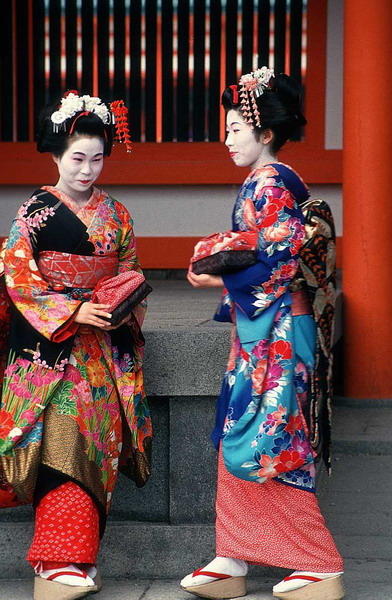Travel, Teach, Live in Japan
A traditional female entertainer who provides music, song, dance, and conversation at dinner parties. "Geisha", pronounced /ˈgeɪʃә/ in English, is a proper noun. Like all Japanese nouns, there are no distinct singular or plural variants of the term. The word consists of two kanji, 芸 (gei) meaning "art" and 者 (sha) meaning "person" or "doer". The most direct translation of geisha into English would be "artist" or "performing artist".
Another term used in Japan is geiko, a word from the Kyoto dialect. Full-fledged geisha in Kyoto are called geiko. This term is also commonly used in the region to distinguish geisha practiced in traditional arts from prostitutes who have co-opted the name and attire of geisha (see below). Prostitutes wear the bow of their sash, or obi, in front of their kimono, but geisha wear their obi at the back. True geisha usually had the luxury of a professional aide to help them in the difficult process of dressing; their clothing is made up of several layers of kimono and undergarments, and an obi is more than a simple band of cloth. Dressing could take over an hour, even with professional help. Prostitutes, however, had to take off their obi several times a day, so theirs were far less complex, and tied at the front for ease of removal and replacement.
Apprentice geisha are called maiko (舞子, lit. "dance child"). It is the maiko, with her white make-up and elaborate kimono and hairstyle, that has become the stereotype of a "geisha" to westerners, rather than the true geisha. A woman entering the geisha community does not have to start out as a maiko, having the opportunity to begin her career as a full geisha. In fact, a woman above 21 is considered too old to be a maiko and becomes a full geisha upon her initiation into the geisha community. However, those who do go through the maiko stage enjoy more prestige later in their professional lives.
Tokyo geisha generally do not follow the ritualized Kyoto maiko apprentice process. The training period can be six months to a year – notably shorter than a Kyoto maiko – before she debuts as a full geisha. The trainee is referred to as a han'gyoku (半玉) or "half-jewel", or by the more generic term o-shaku (御酌), lit. "one who pours (alcohol)". On average, Tokyo geisha tend to be older than their Kyoto counterparts, many holding formal degrees from university.
From: Wikipedia















